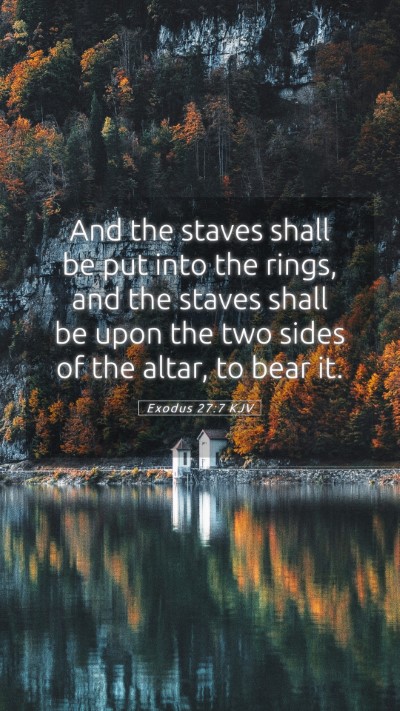Understanding Exodus 27:7
Bible Verse: Exodus 27:7 - "And the staves shall be put into the rings, and the staves shall be upon the two sides of the altar to bear it."
Verse Meaning
This verse outlines specific instructions regarding the altar within the Tabernacle, emphasizing the importance of mobility and functionality for the sacred items used in worship. The staves allow the altar to be carried, reflecting the transient nature of the Israelites' journey and their relationship with God.
Insights from Public Domain Commentaries
Matthew Henry's Commentary
Matthew Henry emphasizes the practical aspects of the altar's construction and operation. He notes that the rings and staves were not merely for show but were functional elements that highlighted the altar's role in sacrifices. The staves illustrate the altar's mobility, signifying that God's dwelling was not confined to a permanent structure but rather followed His people wherever they went.
Albert Barnes' Notes on the Bible
Albert Barnes provides a detailed analysis of the construction of the altar. He points out that the inclusion of staves is significant for priests who needed to transport the altar during their travels. This practice underscores God’s desire to be near His people and facilitates worship, regardless of their physical location. The carrying of the altar denotes a continuous connection to God’s presence and the necessity of sacrifices in maintaining that relationship.
Adam Clarke's Commentary
Adam Clarke highlights the symbolic meanings behind the staves. He mentions that these staves can represent support and stability in faith, serving as a reminder for the Israelites that God carries them through their journey. Moreover, Clarke draws parallels between the physical acts of transporting the altar and the spiritual journeys believers undertake, stressing the importance of upholding the elements of worship throughout life’s transitions.
Biblical Exegesis and Application
- Symbolism of Mobility: The ability to transport the altar speaks to God's dynamic relationship with His people. He moves with them and desires to be an integral part of their journey.
- Functionality in Worship: Each detail in the construction of the altar has a purpose, demonstrating that worship should be organized and preparing for communal worship enhances collective faith.
- Connection to Daily Life: Just as the altar was moved as God's people traveled, believers today are reminded to carry their faith into all aspects of their lives and communities.
Cross References
- Exodus 25:12-15 - Discusses the making of the Ark of the Covenant, which similarly includes staves for transport.
- Numbers 4:6-8 - Contains instructions for carrying the altar and its components, ensuring an organized method for transport.
- Hebrews 13:10 - Reflects on the altar's significance, linking it to the New Covenant established through Christ.
Conclusion
Exodus 27:7 highlights the importance of the altar within Israel's worship practices. Understanding its construction and purpose enriches Bible verse meanings and interpretations. The insights from various commentaries provide deeper understanding and clarity for those engaging with Scripture, and these interpretations can greatly benefit Bible study groups seeking to explore the historical and theological significance of the Old Testament. As believers learn how to interpret Bible verses with diligence, they equip themselves with the knowledge necessary for applying Scripture to daily life.


